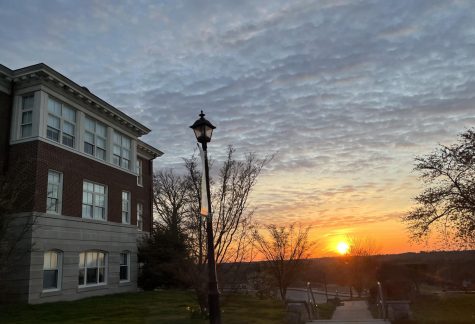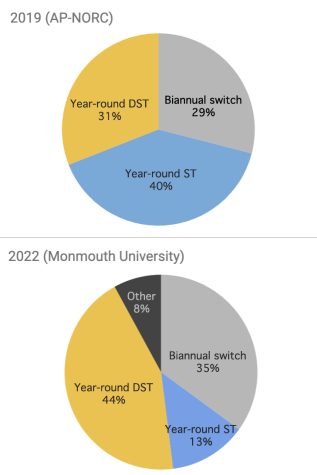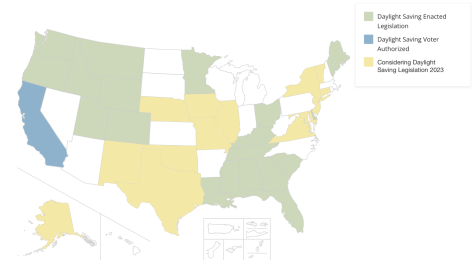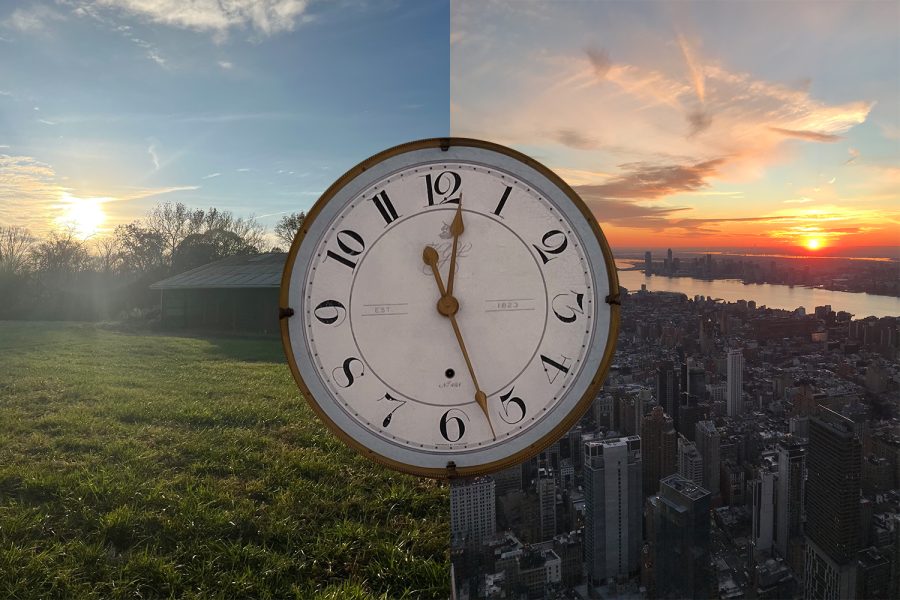Americans debate whether it is time to make Daylight Saving permanent
The history of Daylight Saving Time informs debate on the future of clock changes.
The clock strikes 7 p.m. Outside, the sky is still bright, and the sunset is just beginning to redden the west. Customers are strolling in and out of businesses, while cars stop at gas stations before a sunny evening drive. Students arrive home from after-school activities and eat dinner in natural, non-electric light.
The onset of Daylight Saving Time signals the approach of the warmer months. The United States (US) Senate unanimously approved a bill to make Daylight Saving Time permanent March 15, 2022. The Sunshine Protection Act has not gained approval from the House of Representatives, according to reuters.com. The time changes remain the subject of economic and environmental debate. Mr. Vincent Badagliacca, Upper School History Teacher and Chair of the Upper School History Department, and Ms. Margaret Vondermeden, Mustard Seed Program Teacher, offered their perspectives on the future of Daylight Saving Time.
Continental Americans, with the exception of Arizona residents, use Daylight Saving Time between the second Sunday in March and the first Sunday in November, according to almanac.com. During this period, the sun appears to rise and set later, resulting in dark mornings and bright evenings.

Englishman Mr. William Willet originally proposed Daylight Saving Time in 1907. His pamphlet “The Waste of Daylight” articulates people’s tendency to snooze through sunny mornings and stay awake into darkness by means of artificial light sources. During World War I, Germany, Britain, and the US implemented Daylight Saving Time for the first time, attempting to conserve energy and provide more daylight hours for working, according to almanac.com.
Farmers opposed Daylight Saving Time. They complained that the clock change pushed their morning chores into darkness so that late-rising city workers could enjoy afternoon sunlight. Agricultural advocates also pointed out that livestock and poultry pay no heed to human time systems, resulting in weeks of disruption to farmers’ schedules, according to almanac.com.
As a beekeeper, Ms. Vondermeden affirmed the importance of timing when caring for animals. Whereas dairy farmers, for instance, must rise early for chores, apiarists do not work with bees in the mornings due to cold temperatures. Ms. Vondermeden explained that she begins to work with her hives as the day warms and the bees fly in search of pollen.
Partly due to the grievances of farmers, the US repealed its first experiment with Daylight Saving Time in 1920. The system did not return until Congress enacted it year-round during World War II, again aiming to reduce energy consumption. The practice of shifting the sunset later into the evening reduces the use of electricity for lighting. Reciprocally, brighter afternoons may increase gasoline consumption as people remain active longer. After the war, Daylight Saving Time disappeared until the 1960s, when the US legislated the biannual clock switch, according to almanac.com.

Currently, a majority of Americans prefer to end the switching of the clocks, citing research about the disruption to human health and routine. A 2014 study found that the spring clock change coincides with a 24 percent increase in heart attack visits to hospitals, as patients lose one hour of sleep. After the fall clock change, on the other hand, hospitals reported a 21 percent decrease in heart attack victims, according to smithsonianmag.com. Despite general agreement that clock changes should end, a debate continues about whether to implement year-round Daylight Saving Time or Standard Time, according to almanac.com.
Proponents of permanent Daylight Saving Time argue that brighter afternoons will stimulate economic activity, reduce electricity use, and mitigate seasonal depression. Researchers also suggest that later sunsets guard public safety by lessening crime, according to washingtonpost.com.
Conversely, supporters of year-round Standard Time, including the Florida Parent Teacher Association (PTA), criticize Daylight Saving Time’s dark mornings. They assert that children should not commute to school in the darkness, according to apnews.com. Farmers also continue to oppose Daylight Saving Time, favoring early sunrises for morning work. Still, others see the clock debate as trivial.
Mr. Badagliacca acknowledged the claims from proponents of both time systems. He questioned the soundness of their evidence and conclusions.
“Trying to evaluate the truth or validity of the economic or other arguments put forth by advocates of Daylight Saving Time or Standard Time alone, both now and historically, is an exercise in futility,” Mr. Badagliacca said.
Over the past decade, public opinion has gradually shifted in favor of Daylight Saving Time. An Associated Press and National Opinion Research Center (AP-NORC) poll in 2019 recorded that 40 percent of Americans favored permanent Standard Time and 31 percent favored Daylight Saving Time, according to apnews.com. A poll from Monmouth University in 2022, however, reflected a flip, with 44 percent of Americans supporting year-round Daylight Saving Time, according to monmouth.edu.

Public views remain liable to change. In 1974, the federal government enacted year-round Daylight Saving Time, intending to combat the 1970s gas shortage by curbing energy use. Prior to its passage in January 1974, the proposal had 79 percent approval. By February 1974, though, the experience of dark winter mornings had dropped public support for the system to 42 percent, according to smithsonianmag.com.
Ms. Vondermeden commented that Standard Time’s early sunrises and sunsets promote healthier waking and sleeping patterns. Still, she noted the benefits of sunny afternoons for students and working adults.
“For recreational purposes, the later sun is much more enjoyable,” Ms. Vondermeden said. “You can go to work and come home and still enjoy some of the day, maybe go for a hike or have a barbecue. As for school children, I think the longer afternoons are crucial. I remember when we switched in the fall, it was really rough when the children would come home from school and only have one hour of sunlight to play outside.”
Since 2015, 19 states have passed legislation that will make Daylight Saving Time permanent if Congress amends current federal law. In 2023, 14 additional states will review legislation relating to Daylight Saving Time, according to ncsl.org. Mr. Badagliacca asserted that the time system should not be at the forefront of the legislative agenda.
“Whatever we decide, I think people will adapt,” Mr. Badagliacca said. “Aren’t there more important pieces of legislation to be crafted and considered by Congress than the ‘Sunshine Protection Act’?”
Featured Image by Avery Kim ’24

Avery is honored to serve as one of the Editors-in-Chief of the King Street Chronicle. After two years on the newspaper’s staff, she has learned countless...


